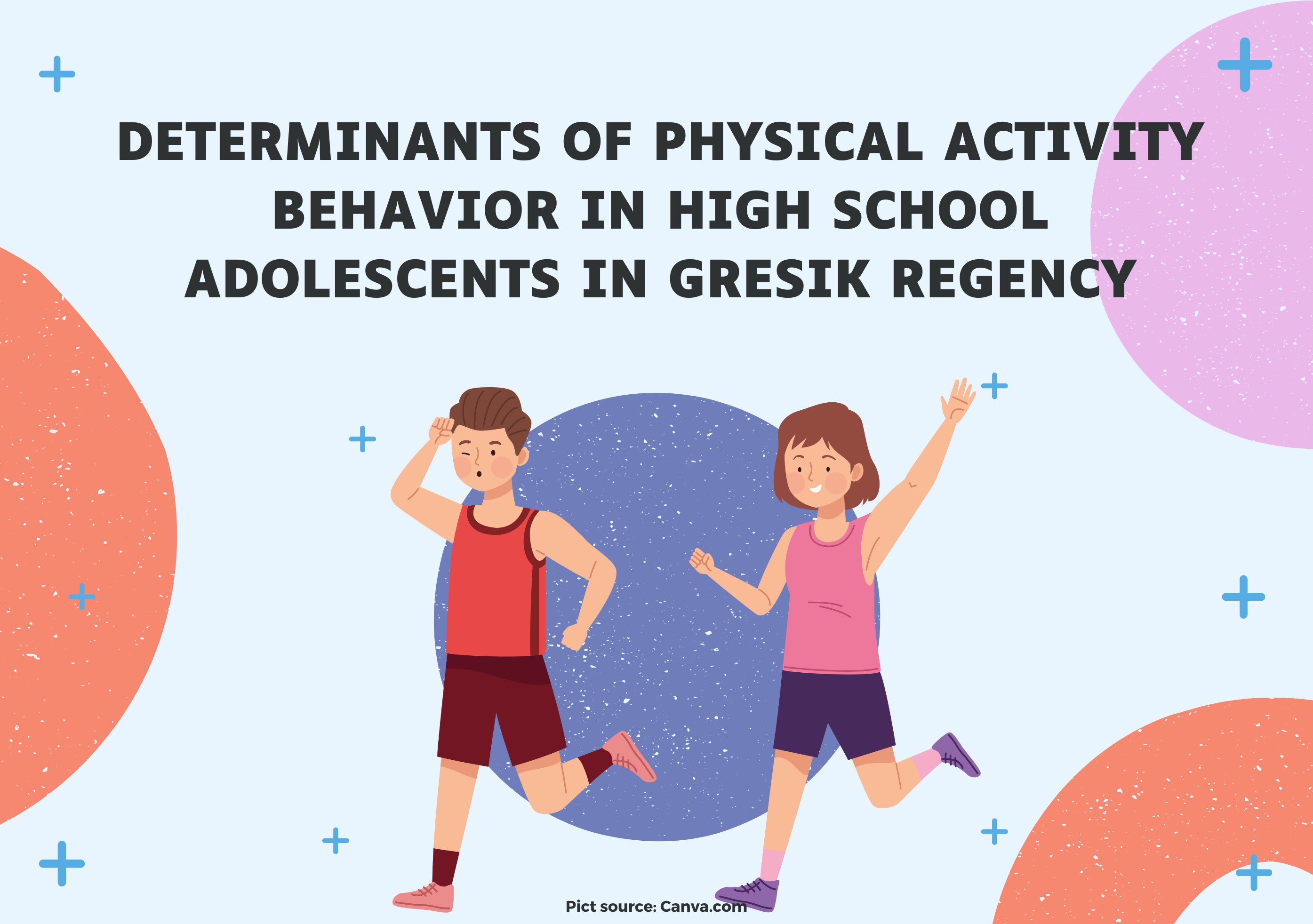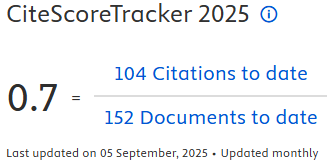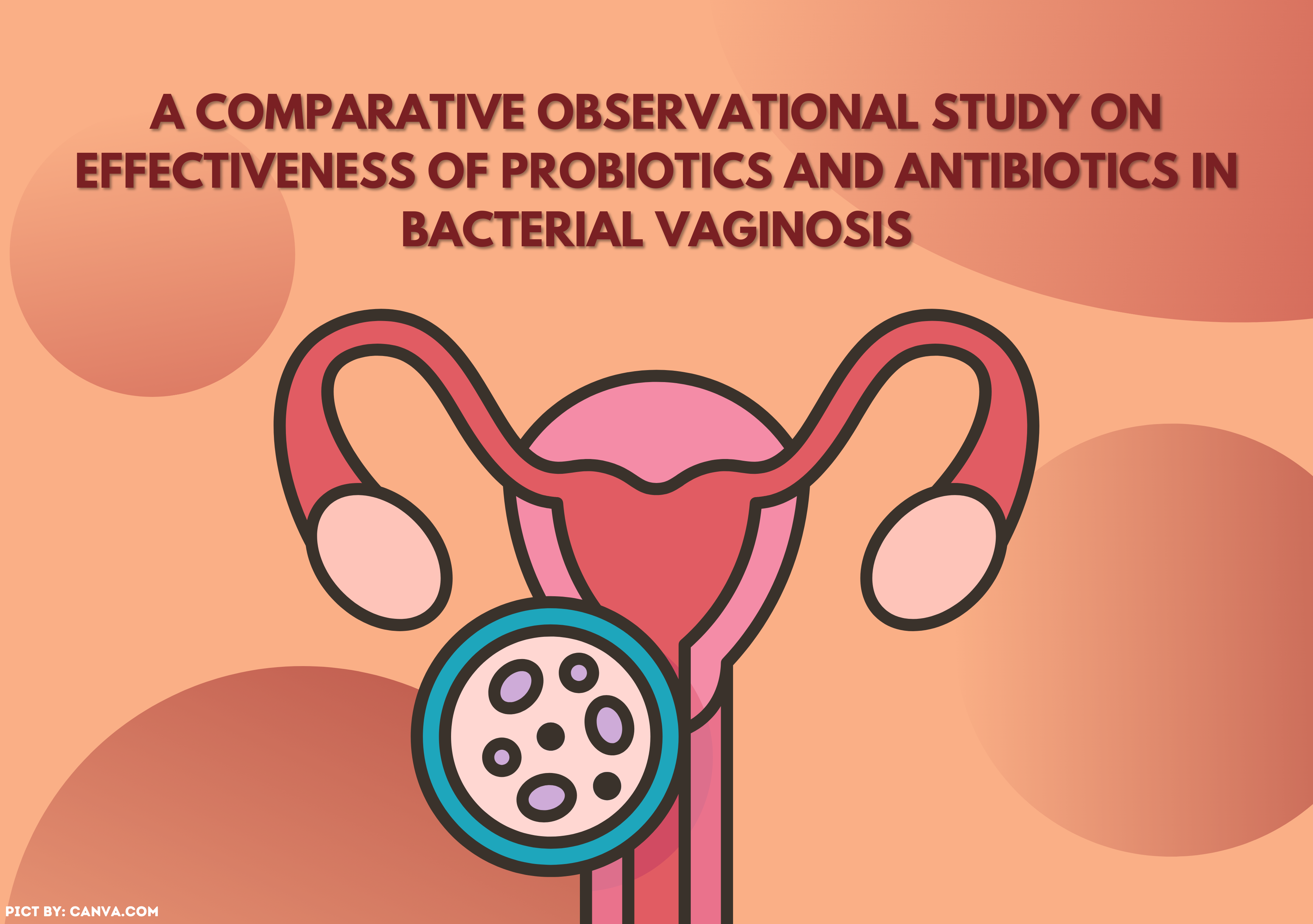DETERMINANTS OF PHYSICAL ACTIVITY BEHAVIOR IN HIGH SCHOOL ADOLESCENTS IN GRESIK REGENCY

Downloads
Introduction: Obesity is one of the global problems as declared by the WHO. In Indonesia, obesity is continuously rising over the years with 12.2% in teenagers aged >15. Therefore, physical activity is one of the prevention efforts to reduce obesity to create a healthy and prosperous life in accordance with the SDGs indicators to campaign for a healthy lifestyle and strive to achieve prosperity for the world community. Aims: This study aims to analyze the factors of physical activity behavior in high school teenagers in Gresik Regency. Method: This study implemented a quantitative approach with the cross-sectional method. The researchers obtained samples for about 360 adolescents with a stratified proportional random sampling technique. The data collection was gathered by completing online questionnaires through Google Forms. The data analysis method employed in this study was the Chi-Square test by observing the relationship in each variable. Result: This study’s result indicates a relationship between gender, social support, and supportive situations with physical activity behavior. However, the age variable demonstrates no relationship with physical activity behavior. Conclusion: Most adolescents in the Senior High Schools of Gresik Regency exhibit moderate physical activity. It means that the majority of respondents have performed physical activity within seven days. Social support, including family support, school support, and peer support, as well as the existence of supportive facilities in the environment around adolescents, can increase physical activity behavior in adolescents.
Akbar, H. (2020) “Pemberian Edukasi Mengenai Obesitas pada Remaja di Madrasah Aliyah Negeri 1 Indramayu,” Community Engagement and Emergence Journal (CEEJ), 2(1), pp, 1–6. https://doi.org/10.37385/ceej.v2i1.123
Amrynia, S. U. and Prameswari, G. N. (2022) “Hubungan Pola Makan, Sedentary Lifestyle, dan Durasi Tidur dengan Kejadian Gizi Lebih Pada Remaja (Studi Kasus di SMA Negeri 1 Demak),” Indonesian Journal of Public Health and Nutrition, 2(1), pp. 112–121. https://doi.org/10.15294/ijphn.v2i1.52044
Babey, S. H., Tan, D., Wolstein, J. and Diamant, A. L. (2015) “Neighborhood, family and individual characteristics related to adolescent park-based physical activity,” Preventive Medicine, 76, pp. 31–36. doi: https://doi.org/10.1016/j.ypmed.2015.04.001
Bélanger-Gravel, A., Gauvin, L., Lagarde F. and Lagarde, M. (2015) “Correlates and moderators of physical activity in parent-tween dyads: a socio-ecological perspective,” Public Health, Sep;129(9), pp. 1218–23. https://doi.org/10.1016/j.puhe.2015.05.019
CDC (2016) “Centers of Disease Controls and Prevention.”
Devís-Devís, J., Lizandra, J., Valencia-Peris, A., Pérez-Gimeno, E., García-Massò, X. and Peiró-Velert. C. (2017) “Longitudinal changes in physical activity, sedentary behavior and body mass index in adolescence: Migrations towards different weight cluster,” PLoS ONE, 12(6), pp. 1–15. https://doi.org/10.1371/journal.pone.0179502
Downward, P. and Rasciute, S. (2016) “‘No man is an island entire of itself.’ The hidden effect of peers on physical activity: John Donne, Meditation XVII,” Social Science & Medicine, 169, pp. 149–156. doi: https://doi.org/10.1016/j.socscimed.2016.09.038
Edwardson, C. L. and Gorely, T. (2010) “Parental influences on different types and intensities of physical activity in youth: A systematic review,” Psychology of Sport and Exercise, 11(6),pp. 522–535. doi: https://doi.org/10.1016/j.psychsport.2010.05.001
Farradika, Y., Umniyatun, Y., Nurmansyah,M.I. and Jannah, M. (2019) “Perilaku Aktivitas Fisik dan Determinannya pada Mahasiswa Fakultas Ilmu - Ilmu Kesehatan Universitas Muhammadiyah Prof. Dr. Hamka,” ARKESMAS (Arsip Kesehatan Masyarakat), 4(1), pp. 134–142. https://doi.org/10.22236/arkesmas.v4i1.3548
Fuentealba-Urra, S., Rubio, A., Flores-Rivera, C., González-Carrasco, M., Oyanedel, J. C., Castillo-Quezada, H., Céspedes-Carreño, C. and Pacheco-Carrillo, J. (2022) “Physical activity habits and their relationship with sociodemographic factors in Chilean adolescents,” Frontiers in Psychology, 13(August), pp. 1–11. https://doi.org/10.3389/fpsyg.2022.915314
Kosnayani, A. S. and Aisyah, I. S. (2016) “Faktor Risiko Yang Berhubungan Dengan Obesitas Remaja,” Siliwangi, 2(2), p. 128.
Kowalski, K. C., Crocker, P.R.E. and Donen, R.M. (2004) “The Physical Activity Questionnaire for Older Children (PAQ-C) and Adolescents (PAQ-A) Manual.”.
Kurdanti, W., Suryani, I., Syamsiatun, N.H., Siwi, L.P., Adityanti, M.M., Mustikaningsih, D. and Sholihah, K.I. (2015) “Faktor-Faktor yang Mempengaruhi Kejadian Obesitas Pada Remaja,” Jurnal Gizi Klinik Indonesia, 11(4), pp. 179–190. https://doi.org/10.22146/ijcn.22900
Lisboa, T., Silva, W. R. D., Silva, D. A. S., Felden, É. P. G., Pelegrini, A., Lopes, J. J. D. and Beltrame, T. S. (2021) “Social support from family and friends for physical activity in adolescence: Analysis with structural equation modeling,” Cadernos de Saude Publica, 37(1). https://doi.org/10.1590/0102-311x00196819
Mendonça, G., Cheng, L. A., Mélo, E. N. and de Farias Júnior, J. C. (2014) “Physical activity and social support in adolescents: A systematic review,” Health Education Research, 29(5), pp. 822–839. https://doi.org/10.1093/her/cyu017
Micklesfield, L. K., Hanson, S. K., Lobelo, F., Cunningham, S. A., Hartman, T. J., Norris, S. A. and Stein, A. D. (2021) “Adolescent physical activity, sedentary behavior and sleep in relation to body composition at age 18 years in urban South Africa, Birth-to-Twenty+ Copphal. 1–14. https://doi.org/10.1186/s12887-020-02451-9
Ministry of Health RI (2018) Basic Health Research 2018. Indonesia Ministry of Health.
Monica, D. (2018) Hubungan Antara Dukungan Teman Sebaya Dan Perilaku Sehat Pada Mahasiswa.
Mutia, A., Jumiyati, J. and Kusdalinah, K. (2022) “Pola Makan Dan Aktivitas Fisik Terhadap Kejadian Obesitas Remaja Pada Masa Pandemi Covid-19,” Journal of Nutrition College, 11(1), pp. 26–34. https://doi.org/10.14710/jnc.v11i1.32070
Pertiwi, Y. and Niara, S. I. (2022) “Pencegahan Obesitas pada Remaja Melalui Intervensi Promosi Kesehatan: Studi Literatur,” Jurnal Ilmiah Kesehatan Masyarakat : Media Komunikasi Komunitas Kesehatan Masyarakat, 14(2), pp. 96–104. https://doi.org/10.52022/jikm.v14i2.278
Rachmayani, S. A., Kuswari, M. and Melani, V. (2018) “Hubungan Asupan Zat Gizi dan Status Gizi Remaja Putri di SMK Ciawi Bogor,” Indonesian Journal of Human Nutrition, 5(2), pp. 125–130. https://doi.org/10.21776/ub.ijhn.2018.005.02.6
Ramchand, R., Ahluwalia, S.C., Xenakis, L., Apaydin, E., Raaen, L, and Grimm,G. (2017) “A systematic review of peer-supported interventions for health promotion and disease prevention,” Preventive Medicine, 101, pp. 156–170. https://doi.org/10.1016/j.ypmed.2017.06.008
Sabar, M. S., Rizal, A. and Juhanis (2019) “Survei Sarana Dan Prasarana Olahraga Terhadap Efektifitas Pembelajaran Penjas Di SMA Negeri 1 Pangkep.” Fakultas Ilmu Keolahragaan, Universitas Negeri Makasar.
Santrock, J. W. (2003) Adolescense. Perkembangan Remaja. Jakarta: Edisi Keen. Diedit oleh Erlangga..
Shi, Z., Lien, N. and Kumar, B. N. (2006) “Physical activity and associated socio-demographic factors among school adolescents in Jiangsu Province, China,” Preventive Medicine, 43(3), pp. 218–21. https://doi.org/10.1016/j.ypmed.2006.04.017
Silva, P., Sousa, M., Sa´, C. andMota, J.. (2014) “Physical activity in high school during ‘free-time’ periods,” European Physical Education Review, 17(1), pp. 3–17.
Sudikno,S., Syarief, H., Dwiriani, C.M. and Riyadi, H. (2015) “FAKTOR RISIKO OVERWEIGHT DAN OBESE PADA ORANG DEWASA DI INDONESIA (Analisis Data Riset Kesehatan Dasar 2013) Risk Factors of Overweight and Obese in Indonesian Adults (Analysis Data of Basic Health Research 2013),” Gizi Indonesia, 38(2), pp. 91–104. https://doi.org/10.36457/gizindo.v38i2.183
WHO (2016) "WHO Guidelines on physical activity and sedentary behaviour."World Health Organization.
Widiantini, W. and Tafal, Z. (2014) “Aktivitas Fisik, Stres, dan Obesitas pada Pegawai Negeri Sipil,” Kesmas: National Public Health Journal, (4), p. 325. https://doi.org/10.21109/kesmas.v0i0.374
Williams, B., Hoskins, G., Pow, J., Neville, R., Mukhopadhyay, S. and Coyle, J. (2010) “Low exercise among children with asthma: A culture of over protection? A qualitative study of experiences and beliefs,” British Journal of General Practice, 60(577), pp. 319–326. https://doi.org/10.3399/bjgp10X515070
Yao, C. A., & Rhodes, R. E. (2015) Parental correlates in child and adolescent physical activity: A meta-analysis, International Journal of Behavioral Nutrition and Physical Activity. https://doi.org/10.1186/s12966-015-0163-y
Copyright (c) 2025 The Indonesian Journal of Public Health

This work is licensed under a Creative Commons Attribution-NonCommercial-ShareAlike 4.0 International License.
- The authors agree to transfer the transfer copyright of the article to The Indonesian Journal of Public Health effective if and when the paper is accepted for publication.
- Authors and other parties are bound to the Creative Commons Attribution-NonCommercial-ShareAlike 4.0 International License for the published articles, legal formal aspect of journal publication accessibility refers to Creative Commons Attribution-NonCommercial-ShareAlike 4.0 International License (CC BY-NC-SA), implies that:
- Attribution ” You must give appropriate credit, provide a link to the license, and indicate if changes were made. You may do so in any reasonable manner, but not in any way that suggests the licensor endorses you or your use.
- NonCommercial ” You may not use the material for commercial purposes.
- ShareAlike ” If you remix, transform, or build upon the material, you must distribute your contributions under the same license as the original.































